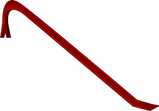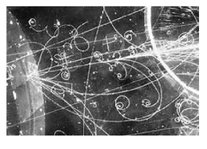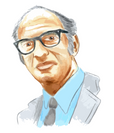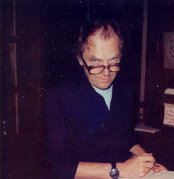The First Unified Theory
The solution to Einstein's Quest
The 12 minutes
Summary:
Ideally, the only thing distinguishing science above other methods for gathering reliable knowledge is its ability to break through the old way of thinking and establish a new that’s more in sync with reality. In praxis, however, the attitude most prevalent at universities is the opposite; the assumption we already know what the world is and that being scientific means defending the present way of thinking. From the universities this attitude spreads downward throughout the educational system until it has been infused in all of us. And - the only thing distinguishing science is gone.
This page offers information that takes about 12 minutes to read. It gives you an introduction to revolutionary-science, an essential component of scientific method, and surpasses the information furnished in 5 standard years at university.
Science’s rules of play – a crowbar
The ideas we laymen have about our world are robust. They’re strong because we build a wall around them; we hold them as truths, whether they’re right or wrong. Everyone knows science’s ideas about the world are equally robust. But few know science’s rules of play are a crowbar constructed for the purpose of breaking through the wall and smashing faulty ideas. Here’s a pocket version that’ll make it easier to break through.
The starting point for today’s material governing theory is the assumption the atom is matter, meaning “physical thing”. How this idea acquired the status of science is a mystery. Normally, science requires hypotheses to be verified before deeming them scientific, but the assumption about a material atom has never been verified in the ordinary way. In addition, no experiment in the history of science substantiates the claim that the entities they call particles are matter. Wherever scientists have searched for or studied matter, what they’ve found are miraculous properties…
A collision between so called "particles" can resemble the picture to the left. Or those in the links here og here.
Picture from Fermilab Today.
Materialists’ reaction to the results of these experiments has generally been bewilderment. In modern physics, the presupposed “thing”, the atom, presents itself like a Christmas tree adorned with miracles, where closer scrutiny reveals the tree itself is gone.
What physics can substantiate is this: The atom is a group of small stable entities regulated by a set of forces. The notion that the atom, in addition, is a thing has never been confirmed or verified as required to be constituted as scientific. Instead, it’s upheld entirely through belief and belongs in a very different faculty, the Faculty of Theology.
For us to make full use of this crowbar, first we have to understand why the wall surrounding our ideas about the world pops up and what it's made of. We can learn only so much from studying other people’s walls. More, if we study one closer to home…
Our own wall
Take for instance, our ideas about climate change. It’s solidly documented that there is a change taking place in the climate and this change has potentially catastrophic consequences. Changes are occurring much faster than can be attributed to natural fluctuations, so they’re most likely manmade. And fossil fuel is the most likely cause. Yet we cling to the idea the changes are due to natural fluctuations and continue our lives as before. Why?
Well. If we switch to the idea it’s manmade, then we’ll have to turn off the spigots for fossil fuel. If we did, a lot more would disappear than just private transportation. We’d have a drastic reduction in material living standard. In short; shifting our ideas about the climate is painful.
What do we do to avoid pain? We mobilize everything we can to build walls. All of us. In unison. We all share a secret, and enthusiastic as we are to pretend we’re good and decent people, we extol completely futile projects as though the solution has been discovered. We applaud everything from an environmental fund, environmental-conscious curriculums, recycling, and electric cars to environmental taxes, building codes demanding thicker insolation, and international agreements like CO2-quotas. All the while the Cause with a capital C remains untouched: the spigots for fossil fuels remain open and every political administration on the planet has plans to leave them open until the sources are tapped dry.
Science’s wall
Shifting ideas is just as painful inside the scientific community as outside. More painful, in fact. These are people whose livelihood is to sell the truth. Changing one’s mind about what constitutes the truth isn’t conducive to a good market price.
But don’t think enthusiasm in safeguarding science’s secrets is due to conscious efforts to conceal something. It doesn’t even have to be. Safeguarding these secrets is directly linked to the goal of a career and all the benefits that come with it. Those goals are conscious. And they create a very effective wall. We seldom hear of a physicist breaking out of the fold who wants to have the Physics Institute transferred to the Faculty of Theology. It’s just as rare to see a biologist break through the wall and become a member of the Norwegian Parapsychological Society. Nor do we often see a member of The Royal Norwegian Society of Sciences open a center for healing and thought field therapy or hold courses in visualizing available parking spots.
What I was taught about science’s game-rules during my 5 years at the University in Oslo is completely useless compared with what you’ll learn here in 12 minutes. For instance, we were never told that in reality, it was cowboys unaware of the group’s secrets who’d unleashed most revolutions in knowledge. We were never told they’d been able to do so because they’d strictly adhered to science’s game-rules or that they’d been met with heavy resistance from the professional scientific community. Nor were we told that every revolution in understanding involved a shift in logic and therefore constituted a breach with established reason.
What we were taught implied it was no longer necessary to heed science’s rules of play. We were told the Truth–meaning the material worldview–had finally been found. From now on scientific chivalry didn’t entail striving to verify the prevailing assumptions in an effort to determine whether the journey in understanding should continue down that path, but to safeguard us from superstition and quasi-science so we can all park at today’s stopping point.
The tourist brochure image of science
Up until the 1960’s, Philosopher of Science Karl Popper was the leading spokesman for the image of science taught at university level. Due to the automatic wall-building we just read about, this image has saturated every institute of higher learning and has never ceased to spread from there down to the rest of us.
Scientific evolution, said Popper, advances from less-good theories to continually better theories, and the changes always occur through the application of logic. The process entailed starting with a foundation of knowledge that was indisputable and continuing step by step with the aid of logic. In this way, the amount of trustworthy knowledge could be extended through a logical process that builds upon the understanding we already have.
The more realistic picture of science
In 1963 Philosopher of Science Thomas Kuhn released his legendary “The Structure of Scientific Revolutions”. In it he points out how not once in the entire history of science has a revolution, meaning a shift from an old theory to a new one, been an extension of the existing understanding, but has always been a breach with it.
Kuhn’s colleague, Paul Feyerabend summed up the new insight saying: “We must make a choice. We can keep science; we can keep reason; we cannot keep both.”
Feyerabend’s statement is well-founded. Shifting theories entails a shift in reasoning. In other words, we can’t cling to what we now believe is a rational way of thinking; we have to let go of it and be willing to embrace a new way of thinking. Let’s take a closer look.
In layman’s terms, a theory is conjectural; an “unconfirmed supposition”. When used in science, it means almost the opposite. In science, a theory is a set of assumptions about natural phenomena that has been verified with positive results.
Making a scientific theory follows a process comprised of two stages:
- Stage 1) The assumptions / Fabrications: Involves inventing a form of logic that show promise in explaining the world.
- Stage 2) The Verification: Is the obligation to investigate whether the world can be explained using this logic.
To switch from an old to a new theory means switching from one theory with a certain form of logic to a new theory with a completely different form of logic - to convert from one line of reasoning to another. Verification involves finding out which theory-candidate can explain more phenomena using its characteristic form of logic. It is a theory’s superior ability in explaining reality that gives it the right to dictate reason. (Endnote 1)
Unexplainable phenomena and signs of crisis
The scientific method Stage 1) Assumptions and Stage 2) Verification, is the foundation for science’s rules of play. The only reason to cling to an old theory is its assumptions’ ability to get through the verification process more or less unscathed. The verification is a process of testing whether the logic is able to explain different phenomena. If it ends up with a considerable number of unexplainable phenomena, the verification results are negative. In that case, the reason for continuing to support the old theory no longer exists.
Agreeing on what constitutes an unexplainable phenomenon is, however, no simple matter. Most scientific activity, a category Kuhn calls normal-science, assumes it already knows what the world is. To protect this belief, explanatory problems must be trivialized:
- Explanatory problems are temporary difficulties. In time, they’ll be solved with material understandinge.
- Explanatory problems aren’t real. They arise because this group of phenomenon doesn’t exist.
- Convenient limits are set for how explainable Nature may be expected to be – we must abandon the commitment to understand everything.
Science’s rules of play – summary
When we use science’s rules of play as tools to find a new theory, the tourist brochure version of science disappears in a puff of smoke:
- Unexplainable phenomena become science’s diamonds.
- If we’re to have any hope of finding a new theory, we must look for it outside established reason.
- All breakthroughs yielding new theories are the result of irrational creativity.
In due time we’ll compare the solidity of the old matter-based theory with the new idea-based. Science’s rules of play tell us how we can do that.
We cannot let professional science use the logic in the material theory-candidate to weigh the idea-based candidatee. (Endnote 2) This violates the rules of play! Nor can we fall for the temptation of using the idea-based theory’s logic to judge the material candidate. This also violates the rules of play! To uphold the game-rules, it’s imperative we do the following:
We must rise above subjective scales. We must weigh each hypothesis based on its ability to explain phenomenon using its characteristic logic. The hypothesis that can explain more phenomena will then have been measured with science’s yardstick and found to be the more solid. This hypothesis gains the right to dictate what is rational. It becomes the dominant governing theory. (Endnote 3)
Crowbars in pocket format
No matter what established reason advocates, no matter what we believe, even if we’re absolutely sure reality is the opposite of what the verification reveals – the only thing elevating science as means to gather solid, trustworthy knowledge is the obligation to surrender to the verification results.
Endnote 1
An example from science history:
- The geocentric planetary theory that reigned until five hundred years ago was based on the following fabricated rules of logic: 1) the Earth is the center of the universe and 2) the planets orbit the Earth in circular orbital paths.
- The new heliocentric theory-candidate was based on the following fabricated rules of logic: 1)The Sun is in the center, 2) the planets orbit the Sun in elliptical orbital paths, and 3) the Earth rotates on its own axis. (The new was irrational if and when evaluated using the established logic of the geocentric.)
- The verification revealed the new heliocentric could explain many more phenomena than the old geocentric. Among other things, it could
- accurately predict positions for the different planets
- explain the seasons
- explain the movements of the Moon and its phases
- explain the movements of moons orbiting other planets
- The heliocentric theory-candidate’s form of logic was ultimately accepted as the new form of reason. Not because the geocentric was worse when judged using the heliocentric logic. But because both were weighed on the scale required by science’s rules of play: By its ability to explain the phenomena using its characteristic form of logic.
Before the shift, the old theory dictated what we then believed was rational in regard to the planets’ positions and movements. After the shift, the new dictates what we now think is rational.
Endnote 2
If you look closer, you’ll discover this misunderstanding is central in all the arguments you usually hear from professional science put forth from the freshest student to the most experienced professors. Argumentation of this sort has veered from science’s game-rules and slid into philosophy.
Endnote 3
When you apply this argumentation at the universal level, you’re adhering to the only aspect of science that elevates it above all others. You’re wielding science’s rules of play for all they’re worth as crowbars.
The hallmark "scientific" still means: willing to let science’s game-rules continue to break through old ways of thinking.
Awe-inspiring reality plus one who doesn't already know everything.







